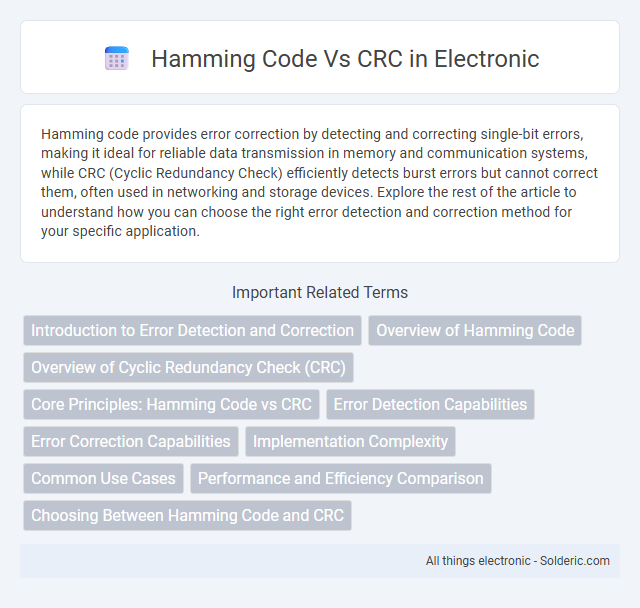Hamming code provides error correction by detecting and correcting single-bit errors, making it ideal for reliable data transmission in memory and communication systems, while CRC (Cyclic Redundancy Check) efficiently detects burst errors but cannot correct them, often used in networking and storage devices. Explore the rest of the article to understand how you can choose the right error detection and correction method for your specific application.
Comparison Table
| Feature | Hamming Code | Cyclic Redundancy Check (CRC) |
|---|---|---|
| Error Detection | Detects single-bit and some double-bit errors | Detects multiple-bit errors with high accuracy |
| Error Correction | Corrects single-bit errors | No error correction; only error detection |
| Code Type | Linear block code | Polynomial-based code |
| Complexity | Simple encoding and decoding | More complex encoding and decoding (polynomial division) |
| Application | Memory error correction, low-error environments | Network communication, data storage integrity |
| Redundancy | Uses parity bits inserted at specific positions | Appends a CRC checksum to data blocks |
| Detection Capability | Limited to errors up to 2 bits in some scenarios | Detects burst errors effectively |
| Standard Use | ECC in RAM, some digital systems | Ethernet, USB, storage devices, communication protocols |
Introduction to Error Detection and Correction
Hamming code and CRC are fundamental techniques for error detection and correction in digital communication systems. Hamming code focuses on correcting single-bit errors by adding parity bits in specific positions, enabling your system to identify and fix errors during data transmission. CRC (Cyclic Redundancy Check) is primarily used for error detection by generating a checksum based on polynomial division, efficiently identifying burst errors but not correcting them.
Overview of Hamming Code
Hamming code is an error-detecting and error-correcting code used to identify and correct single-bit errors in digital data transmissions. It employs parity bits strategically placed within data to detect and pinpoint errors, enabling reliable communication in noisy channels. Commonly used in computer memory systems and communication protocols, Hamming code offers efficient error correction with minimal redundancy.
Overview of Cyclic Redundancy Check (CRC)
Cyclic Redundancy Check (CRC) is an error-detecting code commonly used in digital networks and storage devices to detect accidental changes to raw data. It works by treating data as a polynomial and dividing it by a predetermined generator polynomial, with the remainder serving as the CRC checksum appended to the data. CRC is highly effective at detecting burst errors and provides stronger error detection capabilities compared to simpler schemes like Hamming code, which primarily corrects single-bit errors.
Core Principles: Hamming Code vs CRC
Hamming code relies on linear error-correcting codes using parity bits strategically placed to detect and correct single-bit errors, leveraging syndrome decoding to identify error positions. CRC (Cyclic Redundancy Check) employs polynomial division to generate a checksum that detects burst errors by interpreting data as polynomials over GF(2), prioritizing error detection rather than correction. While Hamming code uses Hamming distance for error correction capability, CRC's error detection strength depends on the choice of generator polynomial, effectively identifying multiple bit errors but lacking built-in correction.
Error Detection Capabilities
Hamming code primarily detects and corrects single-bit errors while identifying double-bit errors, offering robust error detection and correction in low-noise environments. CRC (Cyclic Redundancy Check) excels at detecting burst errors and multiple-bit errors with high reliability but does not correct errors. CRC is widely used in network communications and data storage for its superior error detection capabilities over longer data frames compared to Hamming code.
Error Correction Capabilities
Hamming code provides single-bit error correction and double-bit error detection, making it suitable for environments with low error rates. CRC (Cyclic Redundancy Check) excels in detecting burst errors and multiple-bit errors but lacks inherent error correction capabilities without additional mechanisms. Your choice between Hamming code and CRC depends on whether error correction or error detection is the primary requirement.
Implementation Complexity
Hamming code implementation requires simpler hardware and software, relying on fixed parity-check matrices to detect and correct single-bit errors efficiently. CRC implementation involves more complex polynomial division algorithms and additional logic for generating and verifying cyclic redundancy checks, making it computationally heavier. Your choice depends on balancing the ease of integration in systems against the level of error detection and correction needed.
Common Use Cases
Hamming code is widely used in computer memory systems like ECC RAM to detect and correct single-bit errors, ensuring data integrity in real-time applications. CRC (Cyclic Redundancy Check) is commonly employed in network communications, storage devices, and file transfer protocols for error detection over larger data blocks. Both methods play crucial roles in digital communication and data storage systems, with Hamming code focusing on error correction and CRC on error detection.
Performance and Efficiency Comparison
Hamming code offers faster error detection and correction with lower computational complexity, making it efficient for single-bit error correction in real-time applications. CRC provides superior error detection capabilities for burst errors and longer messages, but at the cost of increased processing time and resource usage. Your choice depends on whether rapid single-bit correction or robust multi-bit error detection is prioritized in your system's performance requirements.
Choosing Between Hamming Code and CRC
Choosing between Hamming code and CRC depends on the error detection and correction needs of the communication system; Hamming code excels in single-bit error correction and limited multi-bit error detection, making it suitable for memory error correction and low-noise environments. CRC offers stronger error detection capabilities for burst errors and is widely used in network communication protocols like Ethernet and Wi-Fi due to its efficiency in detecting multiple bit errors. System designers prioritize Hamming code when error correction is needed with low overhead, while CRC is preferred for robust error detection where error correction is handled by higher-layer protocols.
Hamming code vs CRC Infographic

 solderic.com
solderic.com